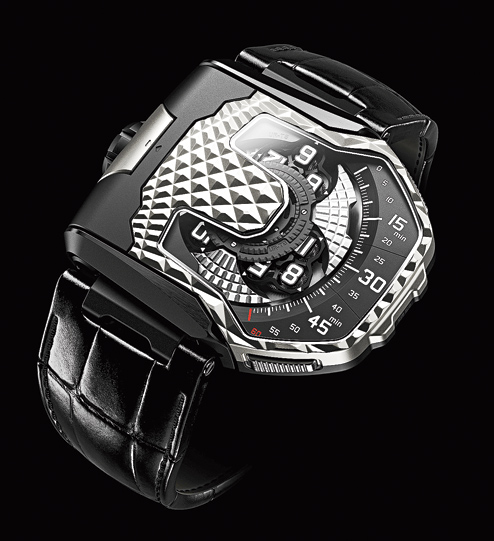What runs but never walks, has a face but doesn’t talk, and has hands but no arms to see?” goes the old riddle. The answer: a watch.
The face-and-hands system of telling the time has been synonymous with watches — with the exception of digital mechanical and electronic ones — since they were created over 400 years ago. But that status quo is now being challenged by a number of new ‘independent’ watchmakers, that is, those that aren’t part of luxury conglomerates like Richemont and LVMH.
Most of the independents, such as Hautlence, Devon and Cabestan, were set up during the last couple of decades or so. “You have these young, talented watchmakers who typically have seen and done it all, honed their skills in the watch departments of big, marquee companies, and then they realised that they wanted to do something on their own,” says Mitrajit Bhattacharya, a leading luxury expert and president of the consultancy, The Horologists. Not surprisingly, they are trying to break with the past.
Ashok Som, professor of global strategy at ESSEC Business School, France, and co-author of The Road to Luxury, says: “What we see now is the next wave of technology that wants to integrate seamlessly what we want to do in our daily routine…. Watches are one of the few items that a man can wear that he believes display true character, signal that he is a member of a particular club… and indulge in a little dose of extravagance without, generally, drawing criticism.” That is why, he feels, like many other industries, the watch industry, too, is also reinventing itself.
MB&F, which is barely 12 years old, calls its products “horological machines” and not “watches”. Others, like five-year-old HYT, are using what they call “hydromechanical technology” that puts fluids — a traditional enemy of machinery — in watches. Devon, a US company, has combined a mechanical movement with electronics and displays the time using belts. And Swiss outfit Cabestan is using winches, drums and a micro form of something like a bicycle chain to wind and run its watches!
The results are quite dramatic. Many of these out-of-the-Batcave machines are hardly recognisable as timepieces. Typically, they are big and audacious. Says Bhattacharya: “You have to differentiate on how to tell the time, largely how you display the time, because that’s where the differentiation is shown very, very clearly.” And collectors and connoisseurs are lapping them up.
According to Julien Schaerer, managing director and watch expert at Antiquorum, a premier watch auctioneer that has been selling watches by independents, “There is a clear separation between vintage and independent watch collectors. Their (independents’) appeal is very different.… Collectors are looking for something hand-made… in low numbers with sometimes some very unusual designs. Resale value is often a secondary consideration compared to the exclusive right to enter a select club.”
Indeed, most of these watches are meticulously handmade in tiny numbers that often do not even go into triple figures and no expense is spared when it comes to ensuring quality. There is also the cost of developing the technologies, some of which can take almost a decade. It isn’t uncommon to see prices in the half-a-million to a million dollar range (about Rs 3 crore to Rs 7 crore), says Bhattacharya. That is at the rarefied end even for established top-line watch brands like Patek Philippe, Audemars Piguet, Breguet, and so on.
The differentiation draws in the buyers. Says Nate Borgelt, auction house Sotheby’s international senior specialist of watches in New York: “It is interesting for a consumer to… see something that is not only new but has something different.”
“This translates well to watches because there have been century-long traditions of telling time.... Companies that are bending the rules have the ability to stand out, whether that be in a different way of physically showing the time, or differentiating themselves mechanically,” added Borgelt of Sotheby’s.
Many of the indie companies are using materials from other industries such as aviation. The aircraft industry uses aluminium extensively to keep weight down. Similarly, indie watchmakers are using the same material for lightness and strength to make some of their watches, some of which can measure more than 50mm across.
Can the new watches hold their value or appreciate significantly as horological assets in the longer term? Schaerer says that’s a difficult question to answer.
“Watches should be compared to similar luxury items and most will devalue just like any luxury car. It is the pleasure of owning and the possibility of enjoying them 24 hours a day on your wrist (that is appealing). It’s only the collectors community and demand that will determine if the price of a watch will go up or down. Some, of course, can appreciate a lot, most will devalue a lot.”
But then, as Borgelt puts it: “There is something to be said for a watchmaker to take something as ingrained in humans as telling the time through traditional methods and attempt to do something different.”
And therein, perhaps, lies their charm.

URWERK UR-T8 TRANSFORMER
Guess what the ‘8’ in the name of this watch stands for? Okay, here’s the answer: That is the motion traced out by a point on the case of this “Transformer” watch when it is flipped over to protect the face! It rarely gets geekier than that. But then, you’re talking about a watch from a company whose whole reason for being is to think out of the box about timekeeping. As in some of Urwerk’s earlier models, a carousel with three rotors marked with the hours also points out the minute on the curved counter. This looks like nothing else on the planet.
Price: Rs 66 lakh approx.

DEVON TREAD 1F
This American company is mixing up electrical and mechanical in a rather interesting way and displaying the result under a perspex cover. The watch indicates hours by a horizontally moving belt, and the seconds by a similar thinner one below it. The minutes are indicated by longitudinal belts that go over the hour belt and under the seconds one. The watch has a distinct ticking sound coming from the seconds belt but allows this to be stopped if less noise and longer battery life is needed. This is one of the few companies in America that is aiming for the hall of high horology.
Price: Rs 12.3 lakh approx.

MB&F HM7 AQUAPOD
Maximilian Busser & Friends, or MB&F, has been making what they call “horological machines”. The latest, the HM7 Aquapod, is a diver’s watch that is inspired by the shape of a jellyfish. Thinking diver’s watch in terms of the Rolex Submariner or the Omega Seamaster won’t prepare one for this device. There is a transparent central sphere around which is the rotating ring to set dive time. Occupying pride of place in the sphere is the central tourbillon. Around it are two sloped rings that rotate on the same axis and display the time below the single marker placed in the six o’clock position for a traditional watch.
Price: Rs 78 lakh approx.

HYT SKULL MAORI
For the rather steep price HYT will charge for the Skull Maori, it will not even give you a mechanism that will let you read off the minutes accurately. Yes, this one shows only the hours by the position of the column of coloured liquid in the fine transparent tube that’s shaped like a skull. Actually, there are two non-mixing liquids in the capillary and how much of each there is, is controlled by the bellows that can be seen through the skull’s mouth. HYT, which calls itself ‘hydromechanical horologists’, started with coloured fluid in a straight tube before going to a smooth circular one and, now, to the skull shape.
Price: Rs 76 lakh approx.

RESSENCE TYPE 1 SQUARED
At first it looks like a regular dress watch. Upon closer observation, what seemed like the minute hand turns out to be a line on a disc. This disc rotates and the line points out the minutes on a fixed ring around it. But there’s more to it. There are three sub-dials in the big disc that show the hour, the seconds and the day of the week and these rotate within the larger disc so that they are always pointing the right way up. This is the Belgian company’s latest take on its ‘Beyond Hands’ concept. The watch keeps changing appearance while going through the same positions every half day.
Price: Rs 12.3 lakh approx.

CABESTAN WINCH TOURBILLON VERTICAL
The mention of winch would typically evoke images of vehicles stuck in mud or sand sooner than they would of luxury watches. But that is exactly what Cabestan is using it for. This is quite a feat of microengineering as a very metallic chain wound around a capstan is what powers this watch. The movement is entirely conceived and made in-house and is shown off under sapphire crystal glass. The time is indicated on drums rotating past indicators while a vertical tourbillon makes the movement “one of the most precise mechanical movements in the world”.
Price: Rs.1.42 crore approx.

HAUTLENCE HL2.5
The fifth watch in the Hautlence portfolio to use the HL 2.0 movement, this is fairly simple in scope and has readings only for hour, minutes and power reserve. It doesn’t even indicate day or date. In this standout timepiece in black diamond-like carbon (DLC)-coated titanium and bright red, the hours are read off a belt with the hour markers. The minutes are marked in a semi-circular arc and the pointer flies back to the zero position at the end of each hour. The polished tourbillon can be seen rotating on the left through the sapphire crystal.
Price: Rs.1.33 crore approx.

CHRISTOPHE CLARET X-TREM-1
With the X-TREM-1 Christophe Claret is pushing at the frontiers of watchmaking technology even though it uses a tourbillon mechanism. While the main mechanism is a nod to traditional watches, the time indicators certainly are not. There are two longitudinal counters next to transparent cylinders that contain hollow spheres. These are not connected mechanically and are moved by magnetic fields along vertical counters on either side of the watch. The hour is read off the left counter and the minutes off the right one. Oh, and for the fabulous price it commands, one still has to wake up each morning and wind it.
Price: Rs 2.05 crore approx.

ROMAIN JEROME SPACECRAFT BLACK
There are two windows that one must look at to read time off this watch. A rotating disc under the top window has a red lacquer indicator for the minutes while the red hour indicator is housed in the bottom facet of the watch.
Hi-tech materials such as black PVD-coated titanium case and carbon fibre-faceted plates are used in this futuristic-looking timepiece. It has a mechanical self-winding movement that uses four different kinds of watch mechanisms to do its job. It’s the statement that the wearer is making that the bulk of the price is for, it seems!
Price: Rs 14.29 lakh approx.










